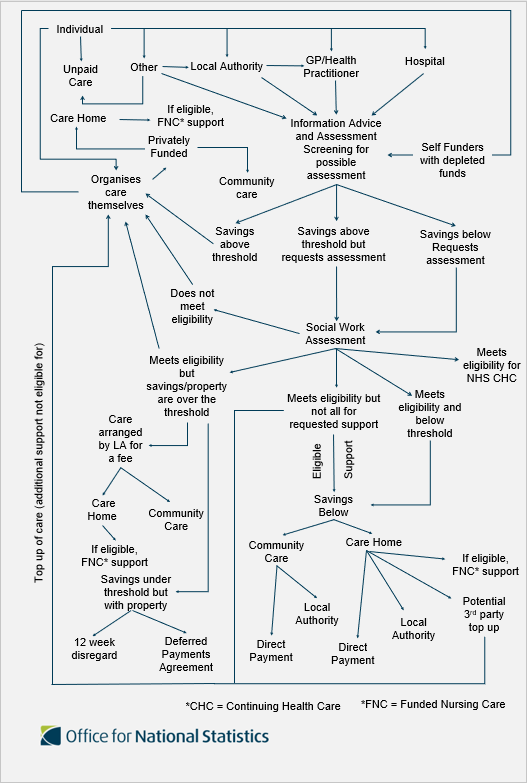Social care: Estimating the size of the self-funding population

Currently, the data on people who self-fund their care is limited. With differences in how data is collected in local authorities and by care providers, there is a significant gap in understanding how care is funded and the impact that has on the adult social care sector. Evie Brown from the ONS, along with Josefine Magnusson from Future Care Capital (FCC), explain how we’re working together to help fill this evidence gap.
The Social Care Analysis team at the ONS is involved in analysing data relating to people requiring social care and previously we published a blog detailing the work being conducted to identify and address gaps in data that could help inform the understanding of adult social care. This includes a programme of work investigating the self-funder population.
A self-funder is typically an individual who organises or funds their care in residential or community settings, as opposed to receiving financial support from the local authority or another third party. There is limited understanding of the self-funder population and the care they receive as there are currently no requirements to include this information in official statistics, which makes it more difficult to estimate the size of the population. At the moment, information about self-funders in the UK are based on data collected by surveys, such as the UK Household Longitudinal Study: Understanding Society.
To improve the statistics around self-funders, a programme of work has been developed by the ONS, with expert sector input from FCC. The initial focus will be to estimate the size of the self-funding population in care homes and the amount that self-funders contribute to this market. Research suggests that self-funders pay, on average, 41% more for a place in a care home than those places funded by local authorities in the same homes. Council paid care home fees are often below what is needed to run a care home, so self-funders are more vulnerable to changes in their fees, as care providers try and cover the costs. The extent of this is not fully understood due to the lack of data specifically focusing on self-funders in care homes.
Estimating the size of self-funders in the community, where an individual receives support in their own home (domiciliary care), will be investigated as part of the wider scope of this work in the future.
Routes to care
To understand the self-funder population, we must first recognise the routes to care available to them. To do this, we’ve developed a “Care Pathways Model” which visualises the various ways an individual could potentially access care in England.

In England, generally someone is not entitled to financial support from a local authority if they have savings above £23,250 and are not eligible for NHS Continuing Healthcare, and therefore can approach a care provider directly. However, there are alternative ways a self-funder can access care. If a self-funder is eligible for Care and Support Services (as assessed by the local authority) they can ask their local authority to organise their care for a fee, using their own funds. If a self-funder owns their own property, they may be part of a Deferred Payment Agreement, where they receive care initially funded by the local authority but is paid back upon a sale of a property.
To provide an accurate estimate of the self-funding population, these differing routes to accessing care must be considered. This involves identifying and linking different administrative data sources from local government, public sector and care providers.
Adult social care in the UK is devolved across the four the nations, meaning different systems organise and fund social care for each country. The initial focus of the work will be to estimate the number of self-funders in care homes in England, with the aim to develop a method which can be implemented across the UK in the future.
Self-funding projections
An additional part of this programme is to develop a model to project the number self-funders in the future. It has been estimated that 25% of self-funders become eligible for local authority support due to depleted funds. Therefore, providing more information about the changes in the number of self-funders in future years, compared to individuals in receipt of state funded support, will help local authorities prioritise resources to support self-funder pickups due to increasing care demand. Identifying key characteristics of the self-funding population will help self-funders receive better advice, earlier, so they can make more informed choices about the care they receive.
The need for data
The Office for Statistics Regulation (OSR) highlighted that the lack of official data on self-funders makes it difficult to estimate the size and expenditure of the self-funding population and the Coronavirus (COVID-19) pandemic has further highlighted other concerns in the sector. A study by the Association of Directors of Adult Social Services in June 2020 found that three quarters of councils have seen a drop in occupancy of residential and nursing homes used mainly by state-funded residents, and over half have seen a decline in occupancy in homes mainly for self-funders, putting financial strain on providers. This work will help to further understand the stability of the care home market and the impact that changes in the self-funding population could have in the future.
People who self-fund their care make up a significant proportion of revenue for care home providers but a lack of comprehensive, standardised and linked-up datais a stumbling block to supporting effective delivery and facilitating improved outcomes for people in social care. This work can help address a key evidence gap in social care statistics, improve the way policy decisions are made and consequently transform the lives of millions of people in the social care sector.
To help improve and develop our care pathways model or if you would like to engage with us further about this piece of work we would welcome any feedback, comments and suggestions to: social.care@ons.gov.uk

Evie Brown
Adult Social Care, Data Science Apprentice

Dr. Josefine Magnusson
Senior Research Officer, Future Care Capital